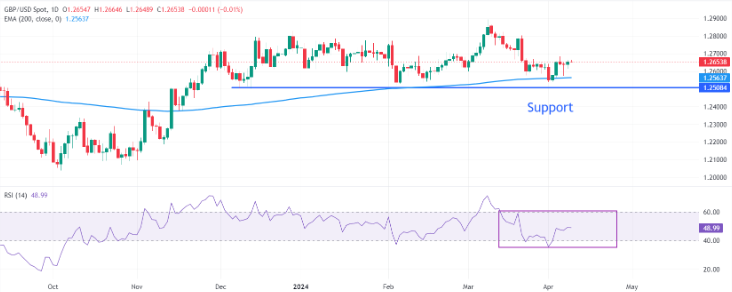- Pound Sterling stabilizes as investors await clearer signals regarding interest rate direction.
- March’s UK Retail Sales show a significant increase in food items sales attributed to an early Easter, yet overall demand remains subdued.
- The upcoming US inflation data for March will provide crucial insight into expectations for potential Fed rate adjustments in June.
During Tuesday’s London session, the Pound Sterling (GBP) remains tightly range-bound around 1.2660 against the US Dollar (USD). Investors’ attention shifts towards the impending release of the United States Consumer Price Index (CPI) data for March, scheduled for Wednesday, which is expected to offer insights into the potential timing of interest rate adjustments by the Federal Reserve (Fed).
Similarly, the US Dollar sees limited movement as markets await the inflation figures. The US Dollar Index (DXY), gauging the Greenback’s strength against six major currencies, hovers just above the 104.00 mark.
On a different note, there’s a slight uptick in demand for the Pound Sterling, fueled by surveys indicating modest growth prospects for the United Kingdom economy this year. Following a technical recession in the latter half of 2023, recent projections from the UK Office for Budget Responsibility (OBR) suggest a forecasted 0.8% growth in the economy for the current year. Despite concerns over geopolitical tensions leading to supply chain disruptions, domestic demand shows signs of recovery, as per the OBR report.
Looking ahead, investor focus remains on the forthcoming UK monthly Gross Domestic Product (GDP) data and February’s factory figures, set to be released on Friday. These metrics will offer a snapshot of the economic landscape following January’s 0.2% GDP expansion. Moreover, sector-specific breakdowns, particularly from the manufacturing sector, will provide valuable insights into overall demand trends, considered pivotal indicators for economic health.
Daily digest market movers: Pound Sterling stays on sidelines, following US Dollar’s footprints
- After rebounding to 1.2660 against the US Dollar, the Pound Sterling stalls as investors turn their attention to the impending release of the United States Consumer Price Index (CPI) data for March, slated for Wednesday.
- Projections suggest that both the US Monthly headline and core inflation, excluding volatile food and energy prices, are expected to have moderated to 0.3% from February’s 0.4%. Annual headline CPI is forecasted to accelerate to 3.4% from 3.2%, while core inflation is anticipated to slow down to 3.7% from 3.8%. These figures will offer insights into when the Federal Reserve might commence interest rate reductions. Market sentiment currently favors the possibility of rate cuts during the June policy meeting, although robust US Nonfarm Payrolls (NFP) data for March has instilled uncertainty. The strong labor market performance reinforces the inflation outlook, potentially postponing rate cut considerations by Fed policymakers.
- In the United Kingdom, speculation surrounding a potential interest rate cut by the Bank of England (BoE) at the June meeting intensifies. UK inflation has fallen below expectations in the initial months of the year. BoE Governor Andrew Bailey’s acknowledgment of two or three anticipated rate cuts this year as “reasonable” adds to the speculations.
- The decline in UK inflation primarily stems from weakened consumer spending. Despite robust spending on food items in March, driven by an early Easter, overall retail sales remain subdued due to dampened demand caused by inclement weather for other goods.
- Conversely, the UK’s economic outlook brightens as major businesses perceive a reduction in economic uncertainty on the horizon. A survey conducted by audit and consultancy firm Deloitte indicates that uncertainties related to Brexit, the pandemic, and inflation, which have overshadowed the business landscape for nearly eight years, appear to be dissipating.
Technical Analysis: Pound Sterling consolidates around 1.2660

The Pound Sterling exhibits a lateral movement as investors anticipate the release of US inflation data for fresh market direction. GBP/USD oscillates around 1.2660, remaining within the confines of Monday’s trading range. Pound Sterling bulls find support near the 200-day Exponential Moving Average (EMA) at approximately 1.2570.
On the downside, the psychological barrier at 1.2500, traced from the December 8 low, stands as a significant support level for the Cable.
The 14-period Relative Strength Index (RSI) fluctuates within the 40.00-60.00 range, indicating a lack of clear direction among traders.
